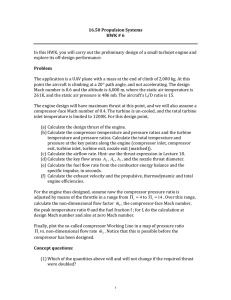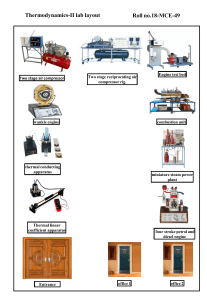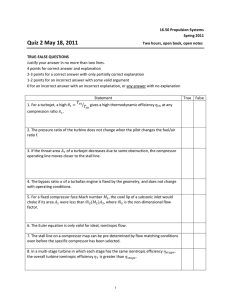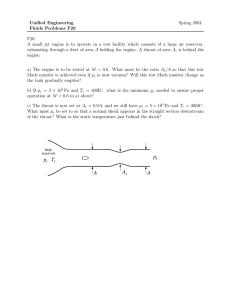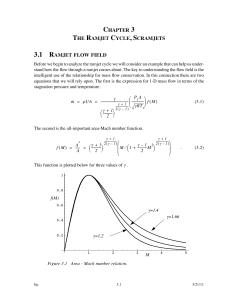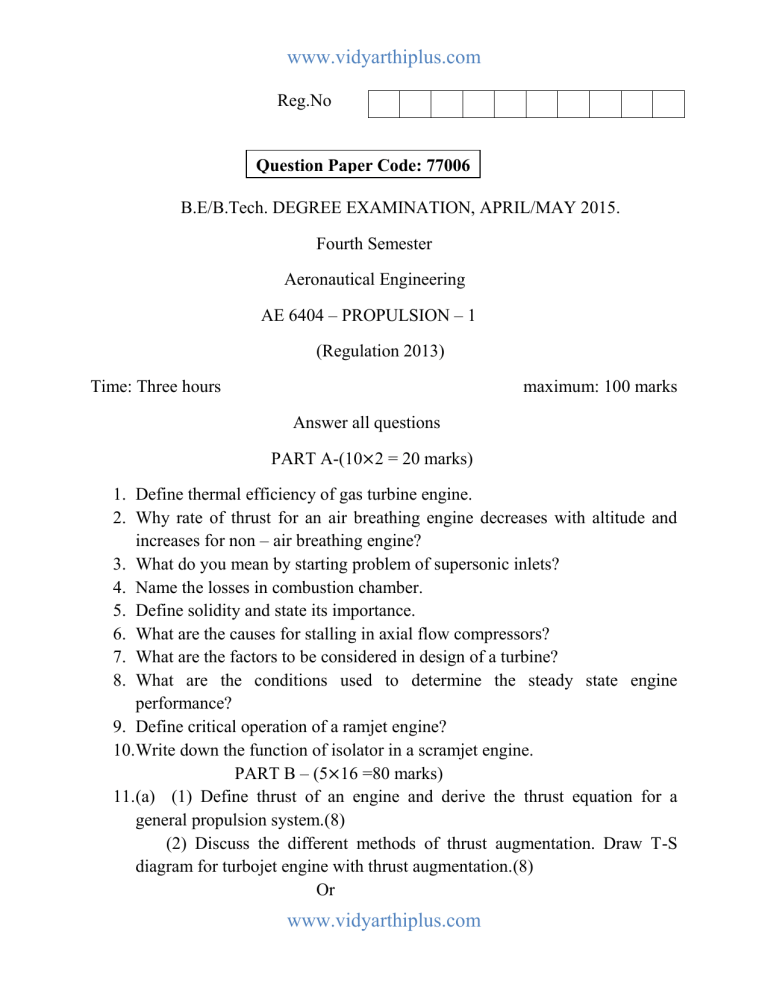
www.vidyarthiplus.com Reg.No Question Paper Code: 77006 B.E/B.Tech. DEGREE EXAMINATION, APRIL/MAY 2015. Fourth Semester Aeronautical Engineering AE 6404 – PROPULSION – 1 (Regulation 2013) Time: Three hours maximum: 100 marks Answer all questions PART A-(10×2 = 20 marks) 1. Define thermal efficiency of gas turbine engine. 2. Why rate of thrust for an air breathing engine decreases with altitude and increases for non – air breathing engine? 3. What do you mean by starting problem of supersonic inlets? 4. Name the losses in combustion chamber. 5. Define solidity and state its importance. 6. What are the causes for stalling in axial flow compressors? 7. What are the factors to be considered in design of a turbine? 8. What are the conditions used to determine the steady state engine performance? 9. Define critical operation of a ramjet engine? 10.Write down the function of isolator in a scramjet engine. PART B – (5×16 =80 marks) 11.(a) (1) Define thrust of an engine and derive the thrust equation for a general propulsion system.(8) (2) Discuss the different methods of thrust augmentation. Draw T-S diagram for turbojet engine with thrust augmentation.(8) Or www.vidyarthiplus.com www.vidyarthiplus.com (b) (1) A turbojet operates at sea level moves at 243.8 m/s. It ingests 113.4 kg/s of air and has negligible fuel flow. The diameter of the exit is 0.762 m. The exit pressure is 151.7 Kpa, and the exit velocity is 396.2 m/s .Find the developed thrust.(8) (2) Discuss the typical turbojet cycle performance with suitable sketches. (8) 12.(a) Air enters a two dimensional supersonic diffuser at a pressure of 14 Kpa, a temperature of 217 K, and with a Mach number of 3.0 The two dimensional oblique shock diffuser has an oblique shock angle of 28°, which is followed by a normal shock. Determine , assuming constant specific heats. (1) The velocity, total temperature and pressure of air entering the oblique shock. (2) The Mach number, the total pressure after the oblique shock. (3) The flow deflection angle (4) The Mach number (5) Total and static pressure and static temperature after the normal shock. Or (b) What are the types of combustion chamber? Compare its advantages and disadvantages. (6) (2) Consider n-Decane fuel, balance the chemical equation for the Stoichimetric combustion of this fuel in air and find the stoichimetric fuel to air ratio.(10) 13. (a) (1) Explain how performance of axial flow compressor can be described by means of compressors characteristics.(8) (2) Explain the basic operation of an axial flow compressor. Prove that power input per stage of the compressor can be written as : 𝑤 = 𝑚𝑈𝐶 a(tan 𝛽1-tan 𝛽2)(8) Or (b)(1) briefly explain th working of a centrifugal compressor with a neat sketch.(6) (2)A centrifugal compressor has an impeller tip speed of 366 m/s. Determine the absolute Mach number of the flow leaving the radial vanes of the impeller when the radial component of velocity at impeller exit is 30.5 m/s. www.vidyarthiplus.com www.vidyarthiplus.com and slip factor is 0.90 Given that the flow area at impeller exit is o.1 m2 and the efficiency of the impeller is 90%.Determine the mass flow rate. Assume that stagnation pressure and temperature at compressor entry are 101.3 Kpa and 288 K respectively.(10) 14.(a) (1) What is the need for matching of compressor and turbine? Write down the matching procedure with suitable sketches.(8) (2) Briefly discuss the methods of turbine blade cooling and mention its advantages and disadvantages.(8) Or (b) The mean diameter of a turbine stage having equal inlet and outlet velocities leads to the following data. Mass flow =20 kg/s, inlet temperature T01 = 1000K, inlet pressure P01= 4 bar. Axial velocity (constant through stage) Ca= 65°, Stage exit swirl angle 𝛼3 = 10°. Determine the rotor blade gas angles, degree of reaction, temperature drop co-efficient and power output .Assuming a nozzle loss co efficient 𝛾N= 0.05,calculate the nozzle throat area required ignoring the effect of friction on the critical conditions. 15.(a) (1) Describe the working of a ramjet engine. Depict the various thermodynamic processes occurring in it on h-s diagram.(8) (2)Draw and discuss the typical variations in pressure, temperature, gas velocity and gas density in a ramjet engine and compare it with scramjet engine. (8) Or (b) A ramjet is to propel an aircraft at Mach 3 at high altitude where ambient pressure is 8.5 Kpa and the ambient temperature is 220 K. The turbine inlet temperature is 2540 K. If all components of the engine are frictionless determine: i. The thermal efficiency (6) ii. The propulsion efficiency(6) iii. The overall efficiency.(4) Let the specific heat ratio be 𝛾 =1.3 and make the approximations appropriate to f<<1 www.vidyarthiplus.com
